
IT IS FANTASTIC IF YOUR PETS GO WITH YOU ON HOLIDAY, BUT IT IS CRUCIAL TO PREPARE WELL TO KEEP THEM SAFE AND STRESS-FREE.
The holiday season is a time for joy, celebration, and making cherished memories with our loved ones – including our four-legged companions. However, as we engage in various festive activities, it’s crucial to prioritize the safety of our pets. From travelling, camping and hiking to beach outings and boat rides, there are numerous potential hazards that pet owners should be aware of. In this comprehensive guide, we will explore tips and precautions to ensure the well-being of your furry friends during holiday adventures and everyday situations. Remember their safety is your duty!
PET ROAD TRIP TIPS
Help Your Dog Love Car Rides: Gradually introduce your pet to car rides to make them enjoyable. Experiment with feeding times and treats to find what works best for their comfort during travel.
Put Safety First: Use a properly sized crate or a crash-tested safety harness to secure your pet in the car. Avoid the front seat and never drive with your pet on your lap to prevent distractions, or accidents and injuries.
Plan Extra Time for Pit Stops: Schedule frequent breaks for bathroom breaks and leg stretches. Have cleanup supplies, leash, harness, and water on hand. Plan for meal times and choose pet-friendly stops for dining.
Pack for Your Pet: Bring essential items like poop bags, food bowls, water, medication, grooming kit, and familiar toys or blankets. Ensure your pet wears a collar with an ID tag, is microchipped and pack a pet first aid kit and a recent photo.
Expect the Unexpected: Road trips may bring unexpected challenges. Be flexible, keeping your pet’s well-being in mind. Consider anxiety-reducing flower essences for nervous pets, and have emergency vet numbers along your route.
Additional tips for travelling:
- If you are crossing borders, make sure you have your pet’s vaccination record card.
- Rubberised floor liners and waterproof seat covers is a good investment for those frequently travelling with pets.
- Microchip your pet and make sure it is registered on multiple databases and in working order before you leave.
- To reduce the risk of carsick, make sure their last meal is at least two hours before you travel.
By following these guidelines, you’ll not only make your road trip enjoyable for your pet but also ensure their safety and well-being throughout the adventure.
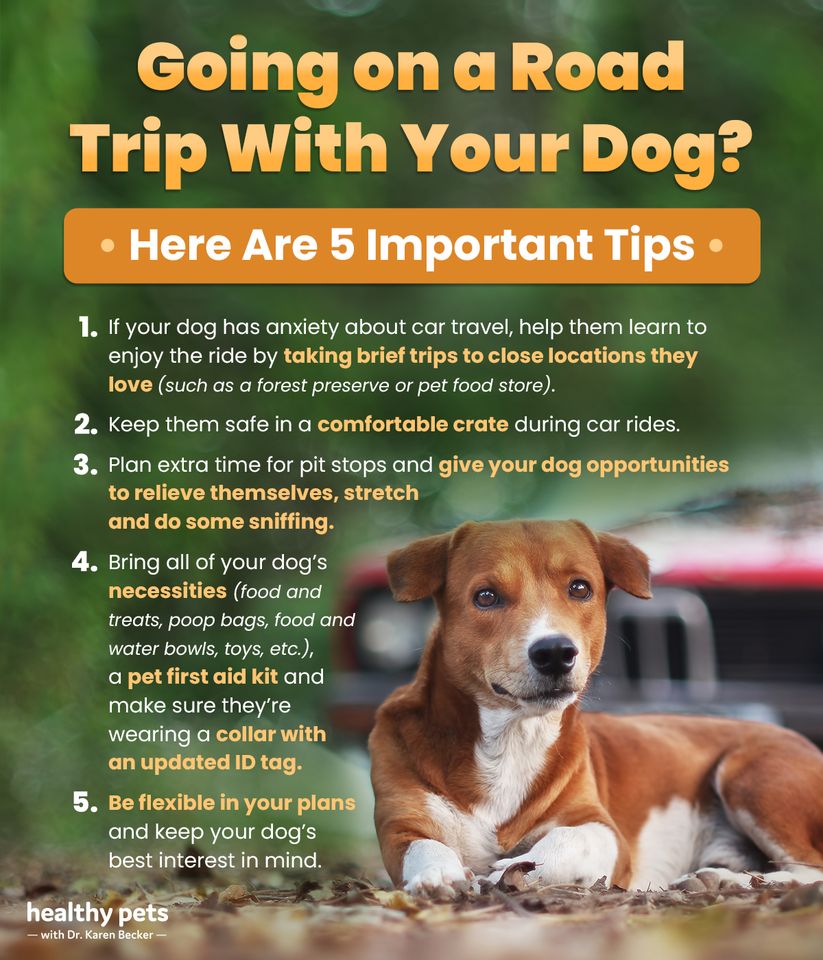
CHOOSING THE RIGHT PET SITTER
Ensuring your dog receives proper care in your absence is crucial, and pet sitters can be an excellent option for this responsibility. Here are some tips to help you choose the perfect pet sitter:
Identify Your Needs: Determine the type of pet-sitting service required, such as daily visits, overnight stays, or home-based care. Consider the specific needs of your dog, whether they care for only dogs or various pets, and their experience with different animals.
Early Start to the Search: Initiate your search well in advance, especially during peak times like holidays. Popular pet sitters tend to get booked quickly, so starting early ensures availability.
Seek Trusted Referrals: Ask for recommendations from trustworthy sources, including friends, family, or your veterinarian. Hearing about others’ positive experiences can help you find a reliable pet sitter.
Conduct Interviews: Meet potential pet sitters in person to gauge their suitability. Arrange for a home visit to observe their interaction with your dog. During the interview, inquire about their experience, training, and emergency procedures.
Key Questions
- Ask about their past experience and the types of pets they have cared for.
- Inquire about any special training, such as animal behavior or pet first aid.
- Discuss emergency procedures and plans for your dog’s care if they fall ill or can’t reach your home.
- Clarify communication methods, including daily updates or photos via text.
- Communication and Preparation: Clearly communicate your dog’s needs and routines to the pet sitter. Provide detailed instructions on feeding, medications, and emergency contacts, including your veterinarian’s information. Write it down as pet sitters might have multiple clients.
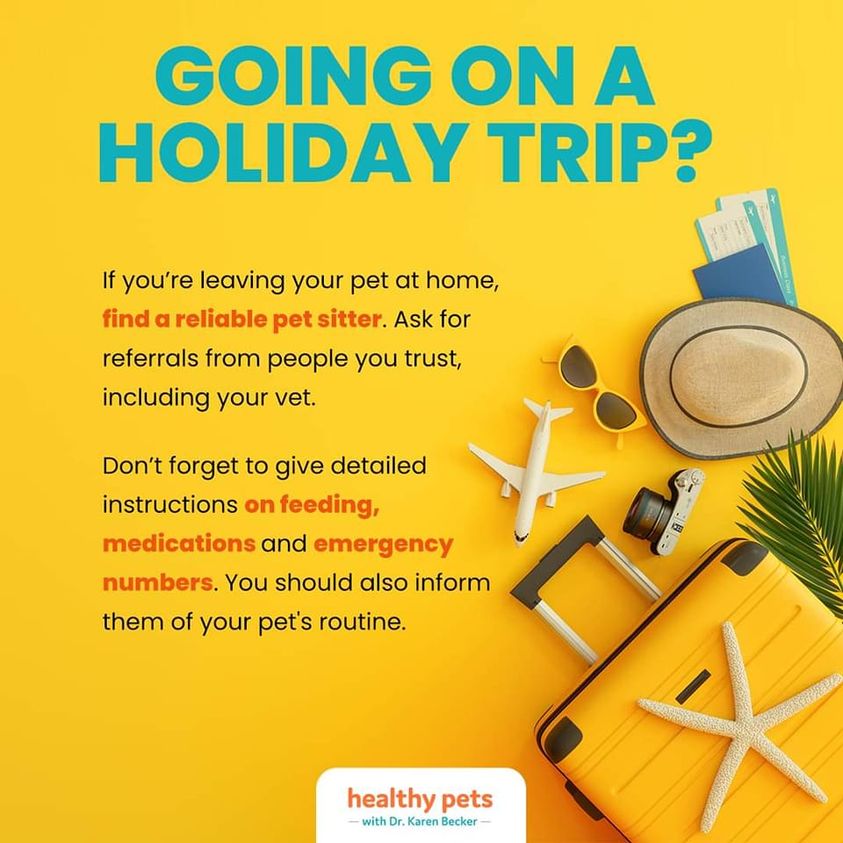
Additional Tips
- Always escape-proof your yard, especially when you are away on holiday and your animals are cared for by a pet sitter.
- List your pet sitter with your veterinarian and provide a backup contact in case of unavailability.
- Leave an extra set of keys with someone else.
- Create a schedule outlining your dog’s routine, including meal times, playtime, walks, and bedtime.
- Keep necessary supplies easily accessible, including extra food, treats, toys, a leash, and a carrier. Leave cleaning supplies in case of accidents.
- Enhancing Comfort
- Request the pet sitter to turn on lights and occasionally play the TV or radio for a homely atmosphere.
- Leave a worn t-shirt near your pet’s bed to provide a familiar scent.
- Ensure a pet-proofed home by securing dangerous items out of your dog’s reach.
Choosing a reliable and caring pet sitter, combined with effective communication, enhances your dog’s well-being during your absence.
HOT WEATHER SAFETY TIPS FOR PETS
Avoid Leaving Pets in Vehicles: Never leave your pet alone in a vehicle, as overheating can be fatal, even with cracked windows. The temperature inside a vehicle can rise rapidly.
Time Outdoor Activities: Schedule walks in the early morning or late evening when temperatures are cooler. Limit outdoor exercise on extremely hot days and keep it brief.
Protect Paw Pads: Test the pavement, ground, or road with the back of your hand. If it’s too hot for your hand, it’s too hot for their paws. Choose cooler surfaces or use protective booties.
Provide Shade and Water: Never leave pets in direct sunlight. Ensure they have access to shade and offer plenty of fresh water to stay hydrated.
Regulate Indoor Temperature: Use air conditioning, and fans, or provide access to cooler areas like basements or darker rooms with tile floors to maintain a comfortable indoor environment.
Special Considerations for Certain Breeds: Take extra precautions for old, overweight, or snub-nosed dogs, such as Boston terriers, Pekingese, Pugs, Lhasa Apsos, Shih Tzus, and Bulldogs. Monitor dogs with heart or lung diseases closely.
Recognize Signs of Heat Stroke: Be vigilant for signs such as panting, difficulty breathing, vomiting, diarrhea, confusion, rapid pulse, bright red gums, and a blue tongue or lips.
Immediate Treatment for Heat Stroke: If you suspect heat stroke, move your pet to a cool place and lower their body temperature with cool (not icy) water. Contact your veterinarian promptly.
Avoid Ice Cubes: Ice cubes are not recommended due to safety factors. Opt for safer cooling methods to protect your pet in hot weather.
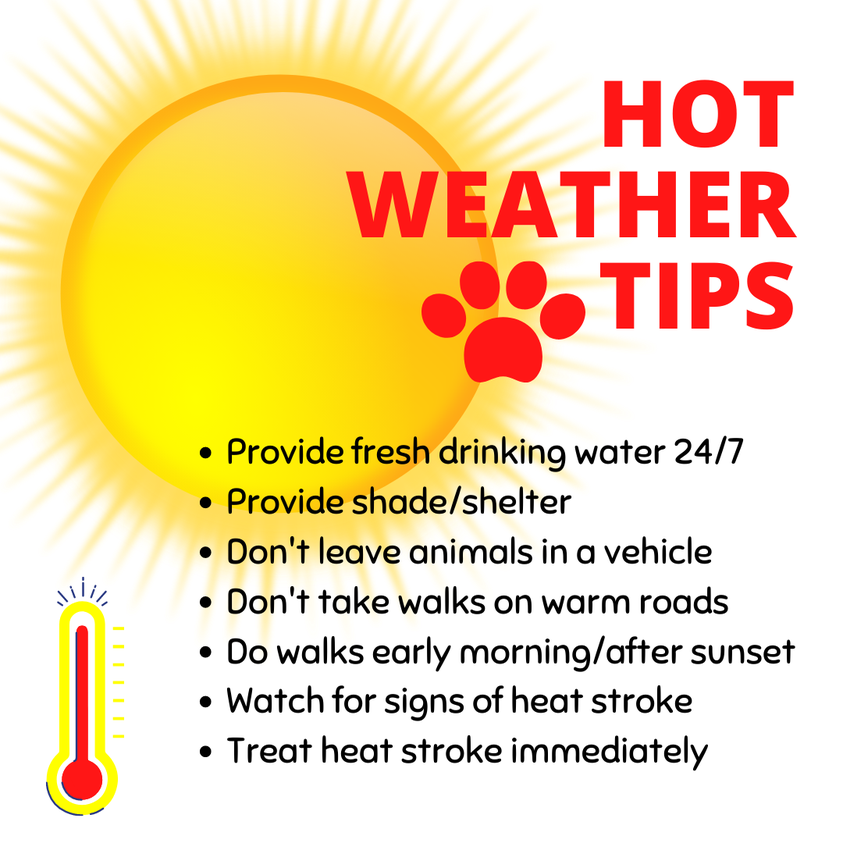
CAMPING AND HIKING WITH PETS
Trail Preparedness: Choose trails suitable for your dog’s fitness level. Gradually acclimate them to longer hikes and varied terrains.
Safety Measures: Leash your dog to ensure control and avoid wildlife interactions. Use a well-fitted harness, and consider a reflective collar for visibility. Does your dog have a good recall and good leash manners?
Always keep your pet on a leash to prevent wandering into potentially dangerous areas. Ensure proper identification with updated contact information.
Make sure your pets are treated for internal and external parasites.
Hydration and Nutrition: Carry enough water for both you and your dog. Bring a collapsible bowl for convenient hydration breaks. Plan for a pre-hike meal and snacks for your furry friend.
Trail Etiquette: Respect trail rules and leash laws. Yield to other hikers, and be mindful of wildlife. Pack waste bags to clean up after your pet.
Appropriate Hiking Gear: Ensure your dog has an up-to-date ID tag or collar, even if microchipped. Don’t forget dog poop bags and a small first aid kit with essential emergency items.
Weather and Wildlife Considerations: Be mindful of the weather conditions, as extreme temperatures can affect your pet. Pack enough water, provide shade, and avoid hot surfaces like asphalt.
Research the area for potential wildlife encounters and take precautions to prevent conflicts. Keep your pet away from wild animals and plants that may be toxic.
Emergency Preparedness: Have emergency contact information, including a vet’s number, and consider an emergency dog sling for remote areas.
Embarking on a hiking and camping adventure with your dog can be a memorable experience when you prioritize their safety and well-being, and adhere to trail etiquette.
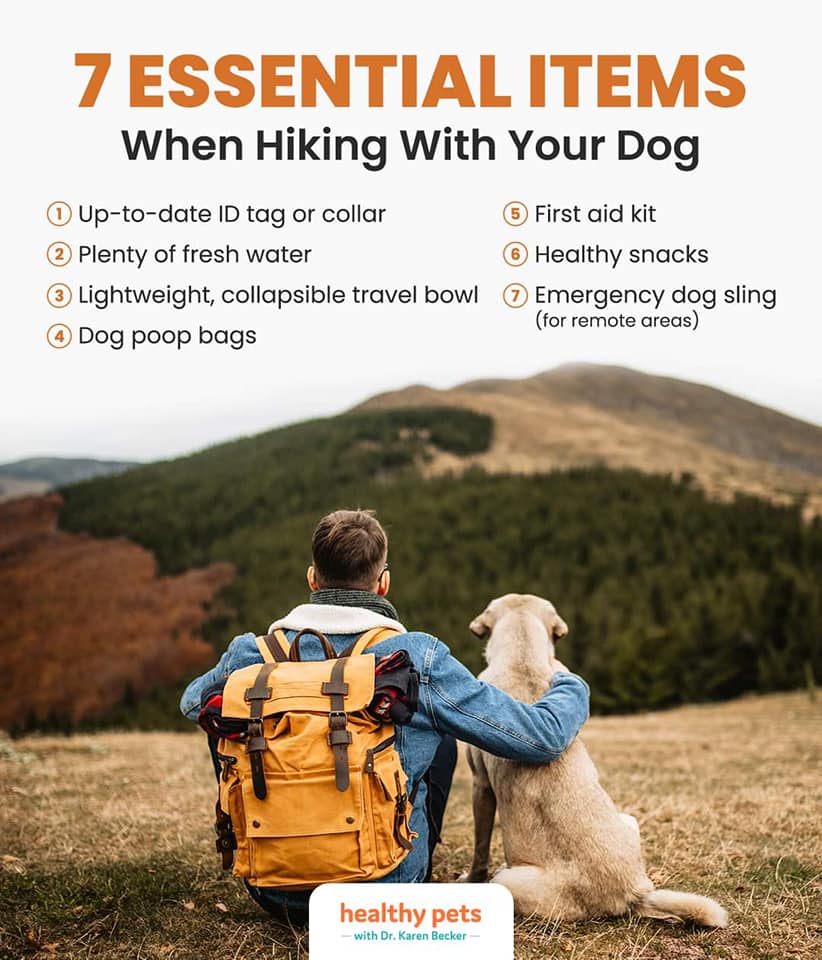
BOAT SAFETY TIPS FOR PETS
Identification: Ensure your dog wears visible ID tags on their collar and consider a microchip. Include your mobile number on the tag for easy contact in case they run off or swim to shore.
Heat Awareness: Avoid taking your dog on the boat in excessively hot and humid weather. Prioritize their well-being by considering the temperature before setting sail.
Water and Shade: Provide access to shade and fresh water on the boat. Pack a dedicated water jug and dish for your dog. Limit time on the water if shade is unavailable.
Leash Usage: Keep your dog on a leash during boarding, while the boat is in motion, and when disembarking. This reduces the risk of running off, falling overboard, or getting hooked while fishing.
Pet-Friendly Sunscreen: Use dog-friendly sunscreen on your pet if needed, and consult your veterinarian for recommendations. Avoid using human sunscreen, as it can be toxic to dogs.
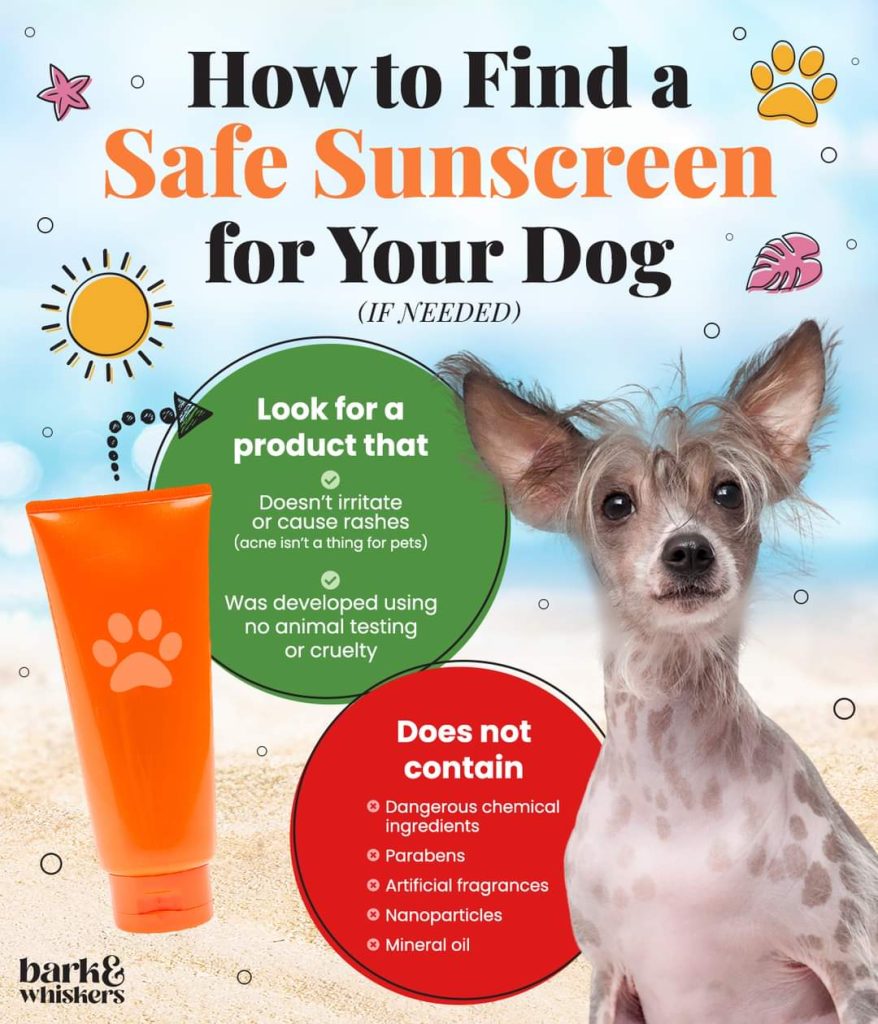
Dog Life Jackets: Ensure your dog wears a properly fitted life jacket. Not all dogs are natural swimmers, and life jackets provide added safety. Avoid water with blue-green algae.
Potty Breaks: Bring pee pads or similar products for extended boat trips. Plan breaks to let your dog relieve themselves onshore if they’re not comfortable doing so on the boat.
Pet First Aid Kit: Pack a pet first aid kit with essentials in case of injuries or emergencies. Include toys for comfort and distraction.
Pay Attention: Monitor your dog’s behavior closely, especially during their first boat trip. Limit the initial outing to a short duration, keep them on a leash, and ensure they are enjoying the experience.
Emergency Plan: Develop an emergency plan in case your dog goes overboard. Assign one person to watch your dog at all times. Be prepared to assist them back on the boat or into the water, depending on their swimming ability.
Whether sailing for a day or an extended period, prioritizing your pet’s safety and comfort will ensure a positive and enjoyable boating experience for both of you.
ENSURING PET SAFETY AROUND POOLS
Remember that not all dogs are good swimmers!
Introducing Swimming: Every pet has a unique approach to swimming. Allow a gradual introduction, avoiding any forceful attempts. Build their confidence in the water through patient and slow-paced familiarization.
Structured Teaching: Take a step-by-step approach to teaching your pet to swim. Begin with shallow waters, progressing to deeper areas. For puppies, introduce them to water between 6 to 16 weeks to establish positive associations.
Supervised Sessions: Always supervise your pet during water activities, especially during the initial learning stages. Offer support under their midsection as they gain confidence and master the use of all four limbs in swimming.
Breed Considerations: Challenged Breeds: Breeds with unique physical characteristics, such as brachycephalic, top-heavy, short-legged, or small breeds, may face challenges in the water. Provide extra assistance and attentiveness.
Special Attention: Puppies, elderly dogs, and those prone to feeling chilled may need additional support during swimming sessions.
Water-Loving Breeds: Breeds with water-resistant coats and webbed feet, like Newfoundlands, standard poodles, Portuguese water dogs, and Labrador retrievers, often show a natural affinity for swimming.
With all outdoor activities, remember pet-safe sunscreen!
Ensuring a positive and enjoyable swimming experience for your pet involves patient introduction and vigilant supervision. These measures not only foster a love for water activities but also prioritize your pet’s safety.
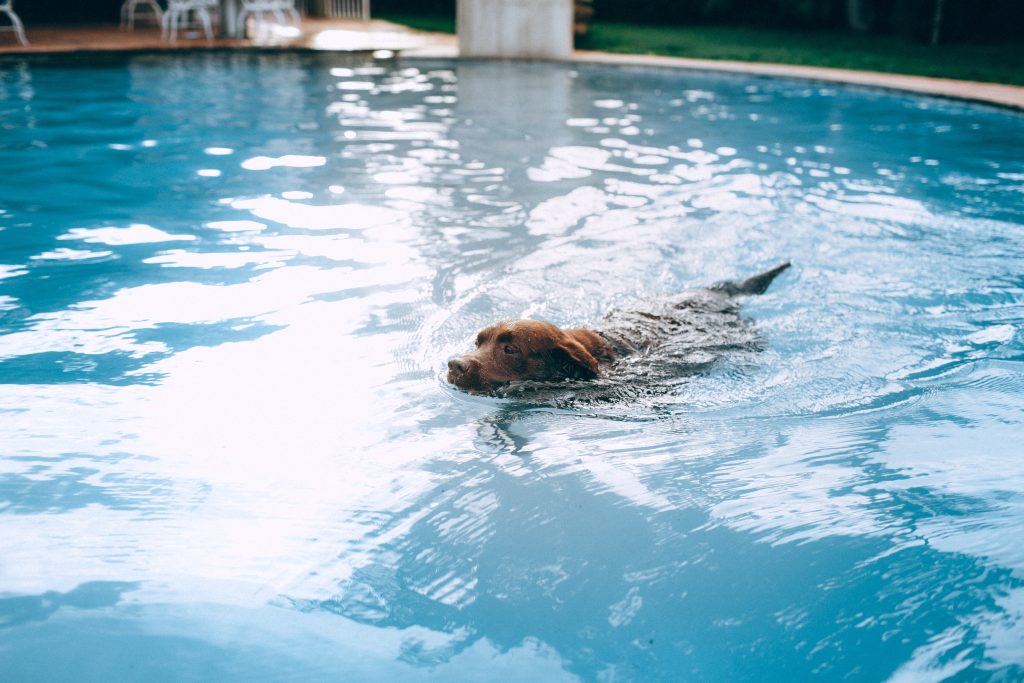
BEACH AND LAKE SAFETY
Supervision: Always supervise your pet around natural water sources to prevent accidental drowning. Consider a life vest for added safety, especially in unfamiliar environments.
Water Quality: Be aware of potential hazards in lakes, such as algae or bacteria. Ensure your pet is up-to-date on vaccinations and take preventive measures for waterborne illnesses.
Swimming Safety: Introduce your pet to water gradually, use flotation devices if needed, and never force them into the water. Be mindful that not all dogs are natural swimmers.
Water Intoxication: Monitor your pet’s water intake, especially during energetic water play, to prevent water intoxication.
Salt Water: Discourage your pet from drinking seawater, as excessive saltwater ingestion can lead to dehydration and salt poisoning.
Seaweed: Keep your pet away from large accumulations of seaweed, as some types can be toxic.
Sand Impaction: Discourage excessive digging and monitor playtime to prevent sand impaction.
Hot Surfaces: Protect your pet’s paws from hot surfaces by providing shade or using protective booties.
Picnic Foods & Foreign Bodies: Be cautious with lakeside picnics, keeping harmful foods and foreign objects out of reach.
Fishing Hooks: Keep pets away from fishing gear to prevent injuries from discarded hooks.
Sun Protection: Apply pet-safe sunblock to exposed areas, especially for pets with light-colored fur or short coats.
Heat and Dehydration: Prevent heat-related issues by providing shade, and fresh water, and avoiding strenuous activities during the hottest parts of the day.
Prioritizing water safety in diverse environments ensures a positive and secure experience for your pet during water activities.
EMERGENCY PLANNING AND LONG-TERM CARE FOR YOUR PETS
Responsible pet ownership involves preparing for the unexpected. Create an emergency plan with your pet’s medical history and care instructions. Designate a trusted person to care for them in case you’re unable to. Additionally, include your pets in your will, specifying a guardian for their long-term care. Regularly update this information, but specifically before you go on holiday, to ensure your pets continue to receive the love and attention they deserve, even during challenging times.
Read more about the necessity for euthanasia in animal welfare.
As you embark on holiday adventures with your beloved pets, prioritizing their safety should be at the forefront of your plans. Whether camping, hiking, enjoying the beach, or traveling, implementing these precautions ensures that both you and your furry companions can create lasting memories while staying safe and secure. By being vigilant and proactive, pet owners can guarantee a joyful and hazard-free holiday season for everyone in the family, including the four-legged members. Enjoy the holiday and be safe!
Next week we will look at the tragedy of the Easter bunny and why you should not be buying your children bunnies and chickens for Easter.
WHEN YOU KNOW BETTER, DO BETTER!